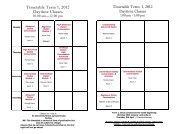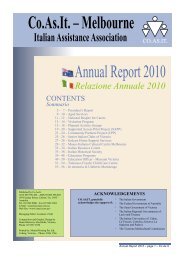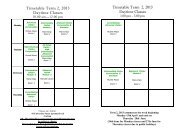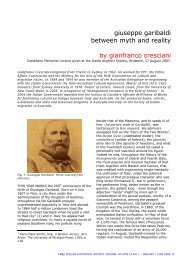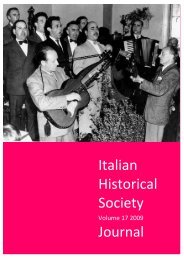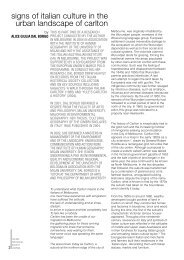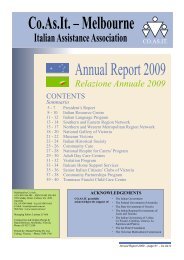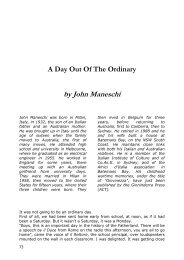Il Centro - Co.As.It
Il Centro - Co.As.It
Il Centro - Co.As.It
Create successful ePaper yourself
Turn your PDF publications into a flip-book with our unique Google optimized e-Paper software.
• In 1775 Alessandro Volta (born in <strong>Co</strong>mo) created the electro-phorus, a device to<br />
generate static electricity. He followed this up in 1800 when he invented the first electric<br />
“pile” which was the forerunner of the battery.<br />
• In 1802 Giandomencio Romagnosi (born in Salsomaggiore) observed the magnetic<br />
effect of electric currents.<br />
• In 1858 the experiments of Romagnosi were followed up by Giovanni Pacinotti<br />
who invented the dynamo (he also happens to have invented one of the very first<br />
parachutes.)<br />
• In 1884 Giuseppe Pirelli (born in <strong>Co</strong>mo) made the first electric cable. In 1889 the<br />
same Pirelli made the first motor car tyre.<br />
• In about 1800 Giovanni Battista Venturi (born at Bibiano Reggio Emilia.) invented<br />
the Venturi meter to compute flow volume. At the same time, he anticipated the<br />
carburettor. The carburetion system based on the Venturi principle is used in motor cars,<br />
airplanes, and wherever motor engines are installed.<br />
• The first motorway was the <strong>It</strong>alian “Autostrada”. <strong>It</strong> ran between Milan and Varese,<br />
was inaugurated in 1924 and would later connect Turin and Venice.<br />
Textile Industry<br />
• The textile industry was born in Sicily in 1130 (despite the fact<br />
that the first crepe textiles were manufactured in Bologna around the year<br />
1000 AD). Tuscany followed in 1226: by the middle of the sixteenth century<br />
Genoa and Venice had come to the forefront. Later France took over as<br />
leading producer.<br />
• In 1339 the technique of <strong>It</strong>alian needlepoint was first applied in<br />
Venice. This "punto in aria" was the springboard for the used of<br />
needlepoint around the world.<br />
• Up to the seventeenth century velvet was made exclusively in <strong>It</strong>aly.<br />
• The interplay between <strong>It</strong>aly and France is historic. Throughout<br />
history there have been a number of fields where <strong>It</strong>aly has started a fashion<br />
and France has taken it over, improved on it and subsequently established<br />
itself as master in that particular field. Such interplay is recorded by<br />
Shakespeare when he differentiates between the two countries in the Merchant<br />
of Venice ( Act 1, Scene 2, line 80): "He bought his doublet in <strong>It</strong>aly, his<br />
round hose in France.”<br />
• In 1884 Gaetano Bonelli (born in Turin) invented the first electric loom.<br />
Spectacles (Eye Glasses)<br />
• Eyeglasses first appeared in Pisa in 1291. Their invention is attributed to one<br />
Alessandro Spina from Florence, a Dominican monk who first used convex lenses to<br />
cure myopia.<br />
• In 1352 Tommaso da Modena was the first painter to depict spectacles.<br />
• In 1480, Ghirlandaio depicted Saint Jerome using an eyeglass. (Saint Jerome is the<br />
patron saint of the London Guild of Spectacle Makers.)<br />
Theatre and Acting<br />
• Acting can be said to have started in <strong>It</strong>aly with the <strong>Co</strong>mmedia Dell’Arte in 1545. The<br />
commedia Dell‟Arte lasted well into the eighteenth century.<br />
• The <strong>Co</strong>mmedia Dell‟Arte became famous throughout Europe and was the first troupe<br />
to go “on tour.”<br />
<strong>Il</strong> <strong>Centro</strong> – <strong>Co</strong>.<strong>As</strong>.<strong>It</strong> Resource Centre Newsletter Volume 17, Issue 2




